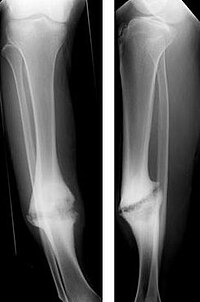
Photo from wikipedia
The treatment of infected and non-infected non-unions remains a major challenge in trauma surgery. Due to the limited availability of autologous bone grafts and the need for local anti-infective treatment,… Click to show full abstract
The treatment of infected and non-infected non-unions remains a major challenge in trauma surgery. Due to the limited availability of autologous bone grafts and the need for local anti-infective treatment, bone substitutes have been the focus of tissue engineering for years. In this context, bioactive glasses are promising, especially regarding their anti-infective potential, which could reduce the need for local and systemic treatment with conventional antibiotics. The aim of this study was to investigate the osteoinductive and osteoconductive effects, as well as the anti-infectious potential, of S53P4 using a standardized non-union model, which had not been investigated previously. Using an already established sequential animal model in infected and non-infected rat femora, we were able to investigate bioactive glass S53P4 under realistic non-union conditions regarding its osteoinductive, osteoconductive and anti-infective potential with the use of µCT scans, biomechanical testing and histological, as well as microbiological, analysis. Although S53P4 did not lead to a stable union in the non-infected or the infected setting, µCT analysis revealed an osteoinductive effect of S53P4 under non-infected conditions, which was diminished under infected conditions. The osteoconductive effect of S53P4 remained almost negligible in histological analysis, even 8 weeks after treatment. Additionally, the expected anti-infective effect could not be demonstrated. Our data suggested that S53P4 should not be used in infected non-unions, especially in those with large bone defects.
Journal Title: Materials
Year Published: 2022
Link to full text (if available)
Share on Social Media: Sign Up to like & get
recommendations!